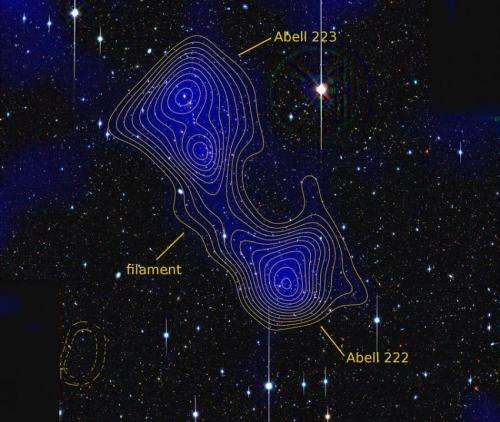July 5, 2012 report
Cosmology group finds measurable evidence of dark matter filament

(Phys.org) -- As time passes and more research is done, more evidence is compiled supporting the theory that suggests that dark matter is a real thing, even though no direct evidence for its existence has ever been found. Instead, the evidence comes about as measurements of other phenomenon are taken, generally involving gravitational pull on objects in the universe we can see that cannot be explained by other means. One of these instances is where weak gravitational lensing occurs, which is where light appears to bend as it passes by large objects. Theory suggests that in cases where lensing occurs but there is no detectable object behind its cause, the reason for it is dark matter exerting a gravitational influence. That has been the case with what are known as filaments; gravitational effects that connect galactic superclusters, keeping them bound together.
Now Jörg Dietrich and colleagues have added credence to the theory by finding a measurable example of lensing in one specific supercluster that cannot be attributable to a visible object. They outline their findings in their paper published in the journal Nature.
Abell 222/223 is a galactic supercluster system in the constellation Cetus. It’s made up of two parts, 222 and 223, separated by a gas cloud and something else that cannot be seen. In looking at data collected by telescopes used to study the supercluster in prior research efforts, Dietrich and his team found that lensing occurred as light behind the gas cloud made its way to us by passing between the two parts. But after careful study and mathematical analysis, they found that the observable matter that existed in the gas cloud could only account for about nine percent of the mass required to cause the degree of lensing that was occurring. Because there was nothing else in the area, the only possible explanation was that dark matter in the shape of a filament was the cause.
The results from this study are doubly interesting; one because they strengthen all of the theories surrounding dark matter, and two, because the team has found a means of not just demonstrating an example of dark matter at work, but have done so in a way that is so precise that they were able to determine the actual shape of a dark matter filament. This second part came about as measurements of lensing were taken at different parts of the area between 222 and 223 showing different degrees of light bending, a feat that was only possible because of the unique way the supercluster is situated relative to us, allowing a nearly straight on view.
More information: A filament of dark matter between two clusters of galaxies, Nature (2012) doi:10.1038/nature11224
Abstract
It is a firm prediction of the concordance cold-dark-matter cosmological model that galaxy clusters occur at the intersection of large-scale structure filaments1. The thread-like structure of this ‘cosmic web’ has been traced by galaxy redshift surveys for decades2, 3. More recently, the warm–hot intergalactic medium (a sparse plasma with temperatures…
Journal information: Nature
© 2012 Phys.org




















